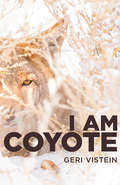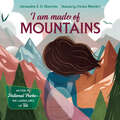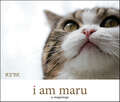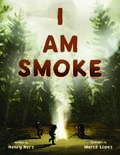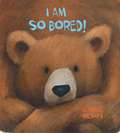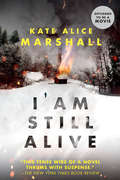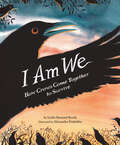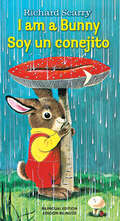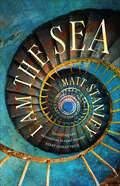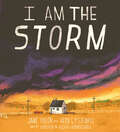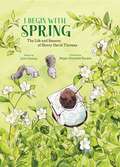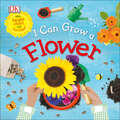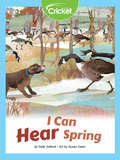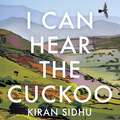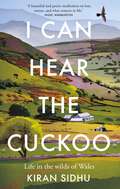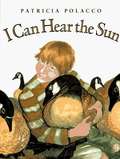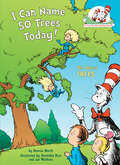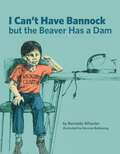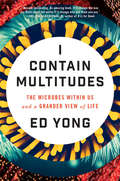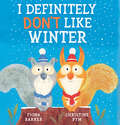- Table View
- List View
Hábitats del mundo (Habitats of the World): Un viaje por los ecosistemas de la Tierra
by DK- Contiene 14 impresionantes ilustraciones CGI a doble página, repletas de la vida vegetal y animal.- Este maravilloso formato ha vendido más de 770.000 ejemplares en todo el mundo.Un viaje ilustrado a través de los hábitats más sorprendentes de la Tierra, desde bosques y océanos hasta desiertos y polos helados.Ilustrado con increíble detalle, Hábitats del mundo explora los principales ecosistemas de la Tierra y las diferentes comunidades de animales y plantas que viven en cada uno. Desde una abundante selva tropical hasta las condiciones hostiles de alta montaña o los polos helados, descubre cómo los animales y las plantas se adaptan a su entorno y cómo interactúan con su entorno y entre ellos.------------------------- Shows 14 panoramic CGI artworks show each major habitat teeming with life.- In the same lavish, landscape format as the successful Through Time series, which has sold over 770,000 worldwide.Beautifully detailed panoramic artworks show each major habitat teeming with life—each scene is packed with drama and intricate details to pore over.
I Am Coyote
by Geri VisteinCoyote is three years old when she leaves her family to seek a home of her own and a mate to share it with. Journeying by night through a Canadian winter, she doesn't know that her search will become a 500-mile odyssey. Nor can she know while enduring extreme cold, hunger, and harrowing brushes with death that she and her descendants are destined to play a vital role in the forests of the eastern United States, replacing wolves (exterminated a century ago) as the keystone predator the landscape desperately needed. Combining rigorous science with imaginative storytelling, I Am Coyote reveals the complex outer and inner lives of coyotes. We are not the only sentient beings on this planet; we are not unique in experiencing love, fear, grief, joy, and acceptance. This magical story will change the way you think about the animals with whom we share the world.
I Am Coyote
by Geri VisteinCoyote is three years old when she leaves her family in Algonquin Provincial Park in Ontario and embarks on a 500-mile odyssey eastward in search of a territory of her own and a mate to share it with. Journeying by night through the dead of winter, she endures extreme cold, hunger, and a harrowing crossing of the St. Lawrence River in Montreal before her cries of loneliness are finally answered in the wilds of Maine. The mate she finds must gnaw off a paw to escape a trap. The first coyotes in the northern U.S., they raise pups (losing several), experience summer plenty, winter hardship, playfulness, and unmistakable love and grief. Blending science and imagination with magical results, this story tells how coyotes may have populated a land desperately in need of a keystone predator, and no one who reads it will doubt the value of their ecological role. Told through the eyes of a coyote, this is a riveting story with mythic dimensions. A work of creative nonfiction that adheres to the highest standards of wildlife biology. With deep insights into wild canine behavior, penetrates the veil of "otherness" that separates us from the animals with whom we share the planet. An appendix explores the history and current status of coyotes in North America. Native Americans considered them tricksters, messengers, and companions. Given the disappearance of wolves, they are even more critical to ecosystem health today. The author explains how, without coyotes, prey species are weakened by disease and parasites. Geri Vistein speaks extensively about coyote-human interactions to a variety of audiences. She is a nationally recognized expert on the topic and maintains the website CoyoteLivesInMaine.com. A QR code in the book takes readers to a hauntingly beautiful recording of coyote song.
I Am Made of Mountains
by Alexandra S.D. HinrichsThis lyrical picture book celebrates the beauty of nature while exploring the diverse landscapes of the National Parks across the United States of America.From the volcanos of Haleakalā National Park in Hawai'i to waterfalls of Yosemite to the churning ocean at Acadia National Park in Maine, I Am Made of Mountains takes readers on a tour to honor America&’s great outdoors. Sixteen parks are highlighted, and the story follows a different child visiting each park and exploring the natural wonders of each location. The lyrical text paired with the expansive illustrations is an ode to the outdoors that will inspire nature lovers and National Park visitors of all ages. <P><P><i>Advisory: Bookshare has learned that this book offers only partial accessibility. We have kept it in the collection because it is useful for some of our members. Benetech is actively working on projects to improve accessibility issues such as these.</i>
I Am Maru
by mugumoguMeet Maru!This round, adorable Scottish Fold cat may be an internet sensation, but he knows how to keep his celebrity status from going to his fluffy head . . . mostly. Maru and his owner, mugumogu, give readers a peek into the low-key life of the world’s most famous cat. See all his favorite hiding places—trash cans, cupboards, cereal boxes . . . if it’s cozy, he’s there—meet his treasured toys, and learn what it means to wield just the right amount of cat-titude.
I Am Smoke
by Henry Herz“Wowww!”—– Raina Telgemeier, #1 NY Times, #1 USA Today, #1 Publishers Weekly bestselling author/illustrator “Herz presents a provocative and unique look at the lifecycle and benefits of smoke throughout the millennia. Lopez’s multimedia artwork further illuminates the ethereal nature of smoke as it drifts and dances across the page.”- John Rocco, NY Times Bestselling author and Caldecott Honoree "A fascinating, refreshing, and beautifully atmospheric take on something often taken for granted. I’ll never look at smoke the same way again!"- Matthew Cordell, Caldecott Medalist author/illustrator “I Am Smoke is an absolutely beautiful book, where smoke is both poetry and science. Readers will rest, float, and dance along with smoke’s quiet power across time and traditions. I have lingered over its pages more than once, and I’m sure young readers will, too.”- NY Times Bestselling author Doreen Cronin Smoke itself acts as narrator, telling us how it has served humankind since prehistoric times in signaling, beekeeping, curing and flavoring food, religious rites, fumigating insects, and myriad other ways. Smoke speaks in mesmerizing riddles: “I lack a mouth, but I can speak…. I lack hands, but I can push out unwanted guests…. I’m gentler than a feather, but I can cause harm…". This rhythmically powerful narration is complemented by illustrations in which swirling smoke was captured on art paper held over smoky candle flames, and the dancing smoke textures were then deepened and elaborated with watercolors and Photoshop finishes. With this unique method, Merce López “let the smoke decide how the idea I had in mind would dance with it, giving freedom to the images.” The resulting illustrations are astounding, and they resonate with the otherworldly text.
I Am So Bored!
by Henrike WilsonA little bear is bored and has no idea what to do with himself. He tries to find a friend to play with him, but no one is around or available yet. Dejected, the little bear lays down on the ground with nothing to do but to stare at the sky or the grass. How boring! Slowly, though, as he sits still, the world begins to come alive around him and his senses are awakened. The grass and the forest around him and the sky above him seem like a very different place and the bear finds himself full of curiosity. He sees things he hasn’t seen before like the shapes in the clouds and feels things he hasn’t felt before like the vibration of a bird’s wings.I Am So Bored! is a book about imagination, slowing down the pace of life, and the power of all five senses. Take a journey with the little bear as he realizes the beauty of life that exists in the world around him. The perfect story to help little ones wind down and to take a break from screen time. Remember: boredom can sometimes be the best way to have fun.
I Am Still Alive
by Kate Alice Marshall<P><P>After Jess is alone. Her cabin has burned to the ground. She knows if she doesn’t act fast, the cold will kill her before she has time to worry about food. But she is still alive—for now. Before Jess hadn’t seen her survivalist, off-the-grid dad in over a decade. But after a car crash killed her mother and left her injured, she was forced to move to his cabin in the remote Canadian wilderness. <P><P>Just as Jess was beginning to get to know him, a secret from his past paid them a visit, leaving her father dead and Jess stranded. <P><P>After With only her father’s dog for company, Jess must forage and hunt for food, build shelter, and keep herself warm. Some days it feels like the wild is out to destroy her, but she’s stronger than she ever imagined. <P>Jess will survive. She has to. She knows who killed her father…and she wants revenge.
I Am We: How Crows Come Together to Survive
by Leslie Barnard BoothA riveting informational picture book that explores the beguiling mysteries of crow behavior. Gorgeous illustrations take us into a crow’s environment and community, making this an incredible—and unforgettable—reading experience.Caw‑Caaaaw! Crows are fascinating and resilient birds. What is the secret to their abundance and survival, especially throughout winter seasons crawling with crow-eating creatures? I Am We unpacks these mysteries, exploring how and why crows roost together by the thousands and their reliance on cooperation and community. Sharing a home in our urbanized ecosystem, crows are the ideal subject for learning about how animals interact with the environment and with each other. With dazzling color illustrations and irresistibly engaging and educational text, this beautiful, bewitching book will delight readers throughout the spooky season and all year round.CROWS ARE EVERYWHERE: Whether hopping along the road or chattering in trees, the common crow has caught the attention of countless kids (and adults). This book turns that attention into an arresting, informative story that reveals how much we have to learn from our neighborhood bird! EDUCATIONAL ENTERTAINMENT: I Am We directly supports learning about ecosystems, interactions, energy, and dynamics while relaying an engaging, suspenseful story that teachers, children, and caregivers won’t want to put down. TEACHES TEAMWORK: Crows have a lot in common with humans: We share an important reliance on community. Focusing on how crows cooperate, communicate, and even cuddle, this picture book highlights the positives of working together to solve a problem, imparting the value of a real-world life skill.Perfect for: Kids who love birds, nature, and exciting facts Teachers and librarians seeking engaging STEM-related resources Birdwatchers and bird lovers Gift-givers looking for a unique Halloween or fall book for kids
I Am a Bunny/Soy Un Conejito
by Ole RisomCuddle up with Nicholas the bunny in Richard Scarry's beloved classic. I am a bunny. My name is Nicholas. I live in a hollow tree.In the spring, Nicholas picks flowers and chases butterflies, and in the summer, watches the frogs in the pond. In the autumn, he sees the animals preparing for the winter. When winter comes, Nicholas watches the snow falling from the sky, then curls up in his hollow tree and dreams about spring. In print for well over 50 years, this beautifully illustrated, gentle story has been a favorite Golden Book for generations.
I Am the Sea: An Isolated Lighthouse Keeper Investigates An Unexplained Death
by Matt StanleyThe tale of a man pushed to the brink of madness- for lovers of Edgar Allen Poe and Robert Eggers' The Lighthouse 1870. Apprentice lighthouseman James Meakes joins two others at the remote offshore rock of Ripsaw Reef... as a replacement for a keeper whose death there remains unexplained.Meakes’ suspicions grow as he accustoms himself to his new vertical world. He finds clues and obscure messages... is there a secret fourth occupant sharing the space, slipping unseen between staircases?With winter approaching, the keepers become isolated utterly from shore. Sea and wind rage against the tower. Danger is part of the life. Death is not uncommon. And yet as the storm builds, the elements pale against a threat more wild and terrifying than any of them could have imagined.‘Unsettling and outstanding’ Kerry Hadley-Pryce‘Ingenious’ Jean Levy‘Spine tingling historical fiction’ @otterly_bookish‘Haunting’ @monsieurmarple‘Rich and vivid’ @annathebooksiread‘Creepy’ @the_book_club__‘Kept me on my toes’ @artbreaker.bookclub‘A story to read with the lights on’ @blottedinkbooks‘Eloquent with beautiful prose’ @thegirlonthego_reads‘Haunting and chilling’ @bookmarkonthewall‘As wild and unpredictable as the tide’ @gothicbookworm
I Am the Storm
by Jane Yolen Heidi E. StempleA tornado, a blizzard, a forest fire, and a hurricane are met, in turn, with resilience and awe in this depiction of nature's power and our own.In the face of our shifting climate, young children everywhere are finding themselves subject to unfamiliar and often frightening extreme weather. Beloved author Jane Yolen and her daughter Heidi Stemple address four distinct weather emergencies (a tornado, a blizzard, a forest fire, and a hurricane) with warm family stories of finding the joy in preparedness and resilience. Their honest reassurance leaves readers with the message: nature is powerful, but you are powerful, too. Illustrated in rich environmental tones and featuring additional information about storms in the back, this book educates, comforts, and empowers young readers in stormy or sunny weather, and all the weather in between.
I Begin with Spring: The Life And Seasons Of Henry David Thoreau
by Julie DunlapHorn Book Starred Review: An excellent introduction to Thoreau and the turbulent times in which he lived. School Library Journal Starred Review: An engaging and inspiring biographical title for budding scientists, artists, and environmentalists. Kirkus starred review: A marvelous life survey of a perennially relevant historical figure. One of Kirkus' Most Anticipated Children's Book of 2022 "A must read." - Elizabeth Bird, A Fuse 8 Production Formatted like a nature notebook, this exploration of seasonal changes in Thoreau’s day is also a visual story of his life and times and a gentle introduction to climate change. I Begin with Spring weaves natural history around Thoreau’s life and times in a richly illustrated field notebook format that can be opened anywhere and invites browsing on every page. Beginning each season with quotes from Thoreau’s schoolboy essay about the changing seasons, Early Bloomer follows him through the fields and woods of Concord, the joys and challenges of growing up, his experiment with simple living on Walden Pond, and his participation in the abolition movement, self-reliance, science, and literature. The book’s two organizing themes—the chronology of Thoreau’s life and the seasonal cycle beginning with spring—interact seamlessly on every spread, suggesting the correspondence of human seasons with nature’s. Thoreau’s annual records of blooms, bird migrations, and other natural events scroll in a timeline across the page bottoms, and the backmatter includes a summary of how those dates have changed from his day to ours and what that tells us about the science of phenology and climate change. Megan Baratta’s watercolors are augmented with historical images and reproductions of Thoreau’s own sketches to create a high-interest visual experience. The book includes a foreword from Thoreau scholar Jeffrey Cramer, Curator of Collections for the Walden Woods Project.
I Can Grow a Flower (Life Cycle Board Books)
by DKA first garden story board book that reveals how plants grow with lift-the-flaps and a pullout height chart.Teach your child how a tiny seed grows into a flower in this fascinating lift-the-flap garden story. A pullout height chart ends the book--a great way for children to remember how a sunflower grows, and to measure how fast your child grows, too! Through illustrations, photography, and flaps, sixteen delightful board book pages reveal the wonder of how plants grow as you follow the story of a mystery seed. How was it planted? What does it need? What will it become? As days go by, it's hard to imagine the tiny shoot will ever grow into a big, strong plant. Could it magically become the tallest of all the garden flowers? Flaps unfold to show plants growing, creatures hiding, and what's happening underground. The book includes very simple gardening projects and facts about garden creatures (which ones are good for plants, and which ones are bad), and children will find out what a pollinator is, and how to attract pollinators to the garden. The perfect gift for aspiring gardeners, complete with a height chart.
I Can Hear Spring
by Sally SelleckHow do you know that spring is finally coming? The geese, of course! All you have to do is look for the V-shape in the sky and listen for all that honking as they migrate back from Canada!
I Can Hear the Cuckoo: Life in the Wilds of Wales
by Kiran Sidhu"A beautiful and poetic meditation on loss, nature, and what matters in life." - Nigel WarburtonFrom the award-winning writer of The New Yorker short film, Heart ValleyKiran Sidhu never thought she could leave London, but when her mother passes away, she knows she has to walk out of her old life and leave her toxic family behind. She chooses fresh air, an auditorium of silence and the purity of the natural world - and soon arrives in Cellan, a small, remote village nestled in the Welsh valleys.At first, the barrenness and isolation is strange. But as the months wear on, Kiran starts to connect with the close-knit community she finds there; her neighbour Sarah, who shows her how to sledge when the winter snow arrives; Jane, a 70-year-old woman who lives at the top of a mountain with three dogs and four alpacas; and Wilf, the farmer who eats the same supper every day, and teaches Kiran that the cuckoo arrives in April and leaves in July. Tender, philosophical and moving, I Can Hear the Cuckoo is a story about redefining family, about rebirth and renewal, and respecting the rhythm and timing of the earth. It's a book about moving through grief and the people we find in the midst of our sadness - and what this small community in the Welsh countryside can teach us about life.(P)Octopus Publishing Group 2023
I Can Hear the Cuckoo: Life in the Wilds of Wales
by Kiran Sidhu"A beautiful and poetic meditation on loss, nature, and what matters in life." - Nigel WarburtonFrom the award-winning writer of The New Yorker short film, Heart ValleyKiran Sidhu never thought she could leave London, but when her mother passes away, she knows she has to walk out of her old life and leave her toxic family behind. She chooses fresh air, an auditorium of silence and the purity of the natural world - and soon arrives in Cellan, a small, remote village nestled in the Welsh valleys.At first, the barrenness and isolation is strange. But as the months wear on, Kiran starts to connect with the close-knit community she finds there; her neighbour Sarah, who shows her how to sledge when the winter snow arrives; Jane, a 70-year-old woman who lives at the top of a mountain with three dogs and four alpacas; and Wilf, the farmer who eats the same supper every day, and teaches Kiran that the cuckoo arrives in April and leaves in July. Tender, philosophical and moving, I Can Hear the Cuckoo is a story about redefining family, about rebirth and renewal, and respecting the rhythm and timing of the earth. It's a book about moving through grief and the people we find in the midst of our sadness - and what this small community in the Welsh countryside can teach us about life.
I Can Hear the Cuckoo: Life in the Wilds of Wales
by Kiran Sidhu"A beautiful and poetic meditation on loss, nature, and what matters in life." - Nigel WarburtonFrom the award-winning writer of The New Yorker short film, Heart ValleyKiran Sidhu never thought she could leave London, but when her mother passes away, she knows she has to walk out of her old life and leave her toxic family behind. She chooses fresh air, an auditorium of silence and the purity of the natural world - and soon arrives in Cellan, a small, remote village nestled in the Welsh valleys.At first, the barrenness and isolation is strange. But as the months wear on, Kiran starts to connect with the close-knit community she finds there; her neighbour Sarah, who shows her how to sledge when the winter snow arrives; Jane, a 70-year-old woman who lives at the top of a mountain with three dogs and four alpacas; and Wilf, the farmer who eats the same supper every day, and teaches Kiran that the cuckoo arrives in April and leaves in July. Tender, philosophical and moving, I Can Hear the Cuckoo is a story about redefining family, about rebirth and renewal, and respecting the rhythm and timing of the earth. It's a book about moving through grief and the people we find in the midst of our sadness - and what this small community in the Welsh countryside can teach us about life.
I Can Hear the Sun: A Modern Myth
by Patricia PolaccoIn true Polacco fashion, the bestselling author of Chicken Sunday and Thunder Cake masterfully intertwines the sensitive themes of homelessness, friendship, and faith into a modern myth that is sure to make believers of us all. An orphaned, homeless boy's love for the geese in a nature park renews everyone's faith in miracles, as he employs his special ability to listen to the sun. Full color.
I Can Name 50 Trees Today! All About Trees: All About Trees (The Cat in the Hat's Learning Library)
by Bonnie WorthLaugh and learn with fun facts about trees like the redwood, white oak, royal palm, and more—all told in Dr. Seuss&’s beloved rhyming style and starring the Cat in the Hat! &“Knowing trees&’ names, my dear miss and dear mister, is like knowing the name of your brother or sister." The Cat in the Hat&’s Learning Library series combines beloved characters, engaging rhymes, and Seussian illustrations to introduce children to non-fiction topics from the real world! Branch out and learn about: the different parts of a treehow to identify different specieswhy a tree has barkand much more! Perfect for story time and for the youngest readers, I Can Name 50 Trees Today! All About Trees also includes an index, glossary, and suggestions for further learning. Look for more books in the Cat in the Hat&’s Learning Library series!High? Low? Where Did It Go? All About Animal CamouflageIs a Camel a Mammal? All About MammalsThe 100 Hats of the Cat in the Hat: A Celebration of the 100th Day of SchoolA Great Day for Pup: All About Wild BabiesWould You Rather Be a Pollywog? All About Pond LifeHappy Pi Day to You! All About Measuring CirclesFine Feathered Friends: All About BirdsMy, Oh My--A Butterfly! All About ButterfliesOh Say Can You Seed? All About Flowering PlantsInside Your Outside! All About the Human BodyIce is Nice! All About the North and South Poles
I Can't Have Bannock but the Beaver Has a Dam
by Bernelda WheelerThis beloved Indigenous classic begins when a little boy asks, &“Mom, can I have some bannock?&” Despite having all the ingredients, Mom can&’t make bannock.As the little boy asks &“why,&” beginning readers learn about the connections between living things in an ecosystem through the ripple effects of a beaver building a dam.Children will be eager to chime in as Mom answers the little boy&’s questions about the power outage in their community and how it impacts his family. Enjoy Mom&’s bannock with your young reader using the recipe in the back of the book.
I Can't Have Bannock but the Beaver Has a Dam
by Bernelda WheelerThis beloved Indigenous classic begins when a little boy asks, &“Mom, can I have some bannock?&” Despite having all the ingredients, Mom can&’t make bannock.As the little boy asks &“why,&” beginning readers learn about the connections between living things in an ecosystem through the ripple effects of a beaver building a dam.Children will be eager to chime in as Mom answers the little boy&’s questions about the power outage in their community and how it impacts his family. Enjoy Mom&’s bannock with your young reader using the recipe in the back of the book.
I Can't Have Bannock but the Beaver Has a Dam
by Bernelda WheelerThis beloved Indigenous classic begins when a little boy asks, &“Mom, can I have some bannock?&” Despite having all the ingredients, Mom can&’t make bannock.As the little boy asks &“why,&” beginning readers learn about the connections between living things in an ecosystem through the ripple effects of a beaver building a dam.Children will be eager to chime in as Mom answers the little boy&’s questions about the power outage in their community and how it impacts his family. Enjoy Mom&’s bannock with your young reader using the recipe in the back of the book.
I Contain Multitudes: The Microbes Within Us and a Grander View of Life
by Ed YongNew York Times BestsellerNew York Times Notable Book of 2016 • NPR Great Read of 2016 • Named a Best Book of 2016 by The Economist, Smithsonian, NPR's Science Friday, MPR, Minnesota Star Tribune, Kirkus Reviews, Publishers Weekly, The Guardian, Times (London)From Pulitzer Prize winner Ed Yong, a groundbreaking, wondrously informative, and vastly entertaining examination of the most significant revolution in biology since Darwin—a “microbe’s-eye view” of the world that reveals a marvelous, radically reconceived picture of life on earth.Every animal, whether human, squid, or wasp, is home to millions of bacteria and other microbes. Pulitzer Prize-winning author Ed Yong, whose humor is as evident as his erudition, prompts us to look at ourselves and our animal companions in a new light—less as individuals and more as the interconnected, interdependent multitudes we assuredly are.The microbes in our bodies are part of our immune systems and protect us from disease. In the deep oceans, mysterious creatures without mouths or guts depend on microbes for all their energy. Bacteria provide squid with invisibility cloaks, help beetles to bring down forests, and allow worms to cause diseases that afflict millions of people.Many people think of microbes as germs to be eradicated, but those that live with us—the microbiome—build our bodies, protect our health, shape our identities, and grant us incredible abilities. In this astonishing book, Ed Yong takes us on a grand tour through our microbial partners, and introduces us to the scientists on the front lines of discovery. It will change both our view of nature and our sense of where we belong in it.
I Definitely Don't Like Winter
by Fiona BarkerHank and Hoog are best friends, but will their friendship survive the coming winter? A heartwarming friendship story perfect for the season!Hank and Hoog are best friends! They do everything together in the summertime. But one morning, a single crisp brown leaf falls on the ground. Hank is devastated. Winter is coming... and Hank DEFINITELY hates winter. But Hoog LOVES winter: the snow, festive spirit, and snuggles.Will their friendship survive the chilly weather?I Definitely Don't Like Winter is a humorous and heartwarming picture book about the friendship and what it means to meet in the middle with someone you love.The perfect read-aloud story for warm- and cold-weather lovers alike!

